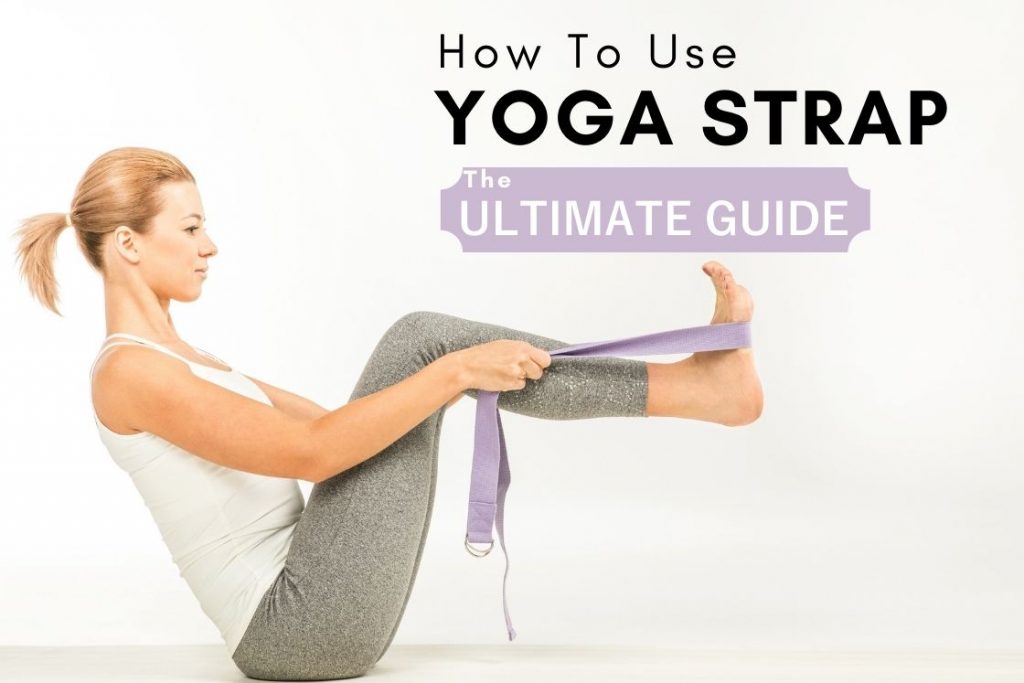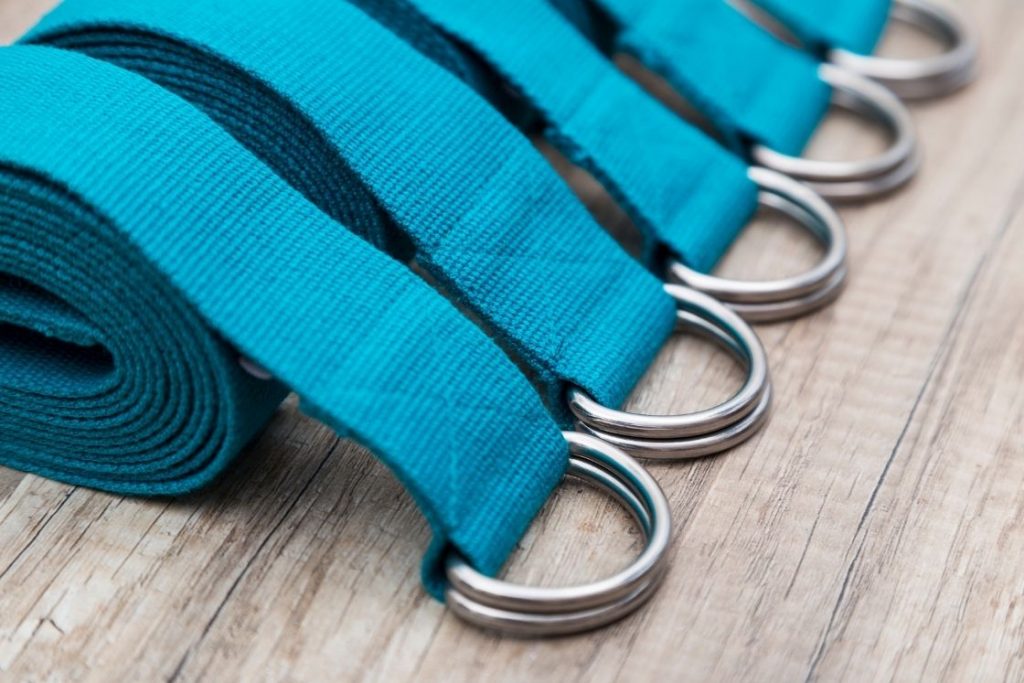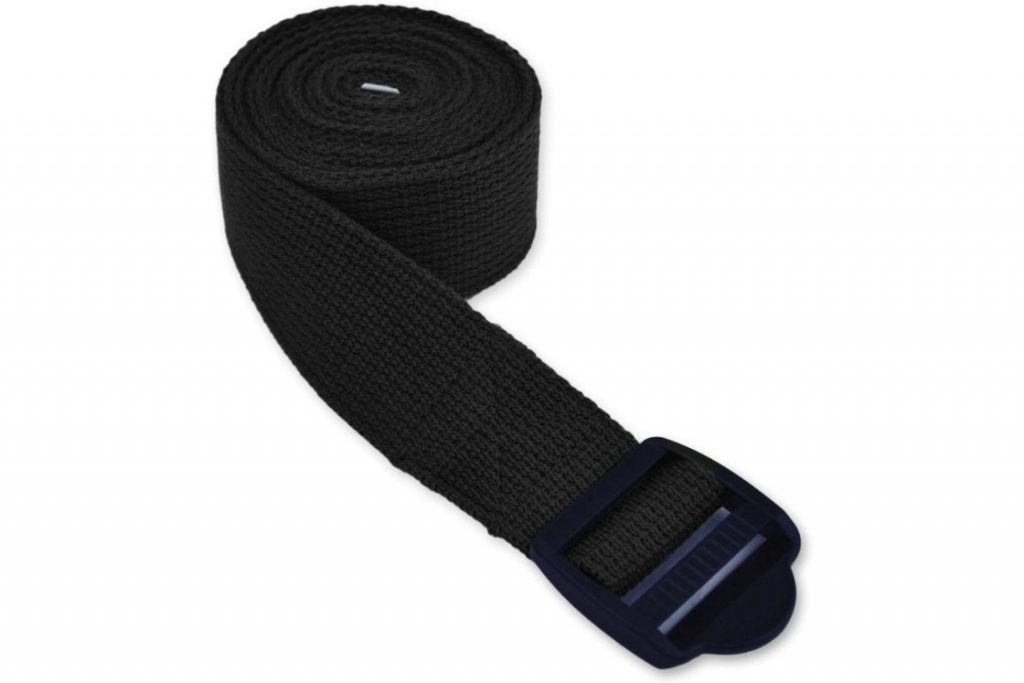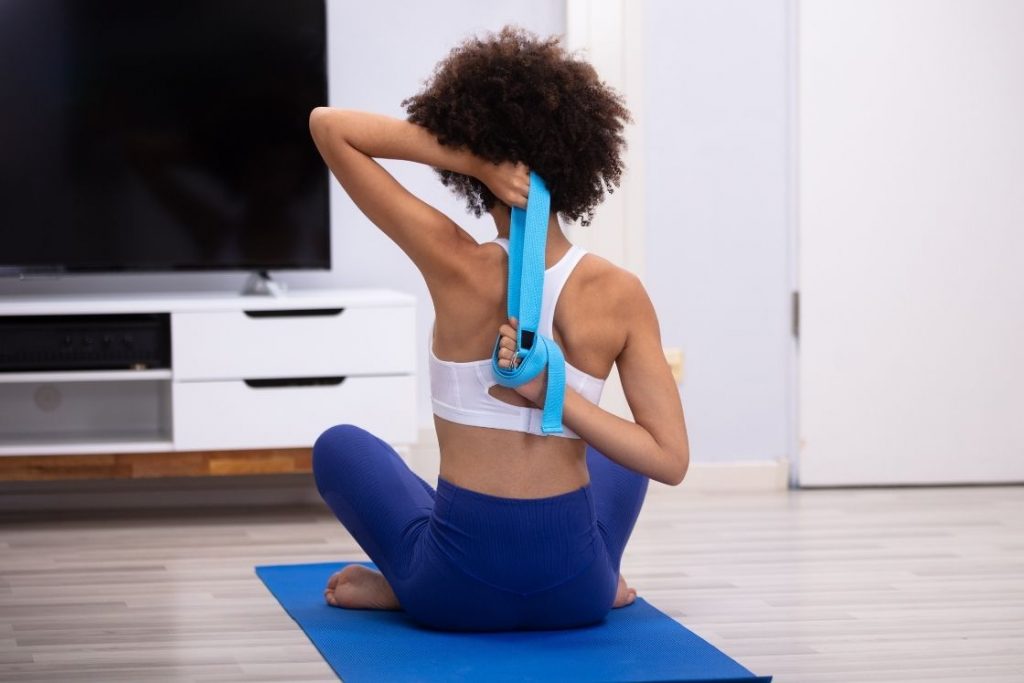A
Ashish
Guest
- Benefits of using it
- Yoga strap types
- Yoga Strap Stretches
- Shoulder
- Hamstring
- Lower back
- Hips
- Neck
- FAQs

Using props and supports in yoga is a common practice. While there is a separate set of yoga styles such as Iyengar, Restorative, and Yin that use yoga props, using support in other traditional yoga forms is also seen frequently. One such prop is a yoga strap.
A yoga strap is a long woven lengthy belt that usually comes with a buckle at one end and another end is empty. It’s mainly used for stretching, alignment and increasing the range of motion in a pose, hence a strap can enhance your yoga practice up to great extent.
The strap is usually made of cotton, hemp, or can be of any other material and is generally 6 to 9 feet long. They come in various colors and varieties to suit the practitioner’s preference.
You can tailor the length of the strap as per the pose, mimic the lengthening of the arm, help in better asana alignment, provide relief from tension in various body parts, and also enhance relaxation.
Apart from the above, they offer a variety of benefits, which we will discuss in the next section.
Benefits of using Yoga Straps
It is interesting to know that yoga straps can be used by anyone, irrespective of them being a beginner or an advanced level practitioner.
Beginners may need to use them as support or when they are unable to reach their toes or hold their hands the back, for example. Advanced practitioners can use them to take an asana to the next level by increasing their body movement or going into a deeper stretch.
For people with tight hips and hamstrings, yoga straps will be beneficial to use in seated asanas. A looped yoga strap can help you with some balancing poses or it can also be used to keep your knees or elbows in line. There are a number of ways through which you can create variations in your asanas using a yoga strap.
Let us look at some benefits a yoga strap can provide.
- Using a strap mimics an elongated arm and helps you reach body areas that are inaccessible. If you’re trying to hold your toes in a seated or balancing pose, putting your feet in a looped strapped can help in putting the leg in a better position.
- If you’re a beginner and are having trouble in alignment and getting the correct posture for an asana, a yoga strap can be of great help. You can use them to keep your back straight by pulling your shoulders back.
- When you use a yoga strap, you can increase the effectiveness of a stretch. You will be able to open your body and make yourself flexible enough for more advanced poses.
- It helps in building resistance and endurance so that you will be able to hold the poses for a longer duration.
- You can use yoga straps to perform some warm-up poses to prepare your body for your yoga session.
- A balanced and stable abdominal area is necessary to maintain any asana which requires balance or core strength. If you keep the yoga straps under the soles and pull them with your arms, it will ease any tension in the abdominal area.
- By using yoga straps, you will be able to hold poses for a longer duration and put less strain, which gets you relaxed and enjoy the benefits of the pose.
- You will have more awareness of the problem areas of the body with the enhanced stretching sensation by using a yoga strap. It makes you aware of how a particular pose works on a muscle, joint, tissue, etc, which you may ignore otherwise.
- People with tight hips, hamstrings, and back pains can be benefitted as it releases the stress causing the pain. Also, you can avoid curving your spine in many seated or bending poses by using a yoga strap.
Different types of yoga straps you can choose from
1. Simple Yoga Strap (with no buckle or ring)
The first type of yoga strap is the one with no metal or plastic ring or buckle attached to any of its ends. They are mostly used by beginner practitioners as they are quite easy to handle. The buckle or belt sometimes creates a lot of sounds which may disrupt the silence and serenity of the yoga class.
These belts are handy and easy to use as compared to their other counterparts. Some people find looping through buckles and ring a complex activity, hence simple yoga straps are best suited for them. And since you are creating a loop by yourself, you do not have to adjust the strap repeatedly and interrupt your yoga practice.
However, if you do not tie the loop properly beforehand or it is not adjusted as per your need, you will be practicing your yoga poses with incorrect alignment. The knot of the loop should be adequately fastened, which may take some time to learn.
2. D-ring Yoga Strap

As the name suggests, this type of metal strap comes with a metal ring, in the shape of a “D” buckle attached to its ends. It is one of the commonly used yoga straps in yoga classes. In a typical D-ring strap, there are two metal D-rings on one end and another end is empty. The empty end is used to thread it through the D-rings to make the desired loop.
You need to prepare your D-ring strap before the class begins. Take the empty end through both loops and then fold it over itself. This empty end will now be on top of the rings. You should now take this non-ringed end through one D-ring to tighten the loop.
This type of yoga strap is quite useful when you want to adjust the loops based on your pose or the body part you want to work on. You can also use it to keep your back straight and maintain proper posture during poses. It is most beneficial for tall people or those who want an extended arm length.
Make sure you have a well-prepared belt. If the loops loosen or come undone in the middle of a pose, it can cause serious injury.
3. Cinch Buckle Yoga Strap

You must have seen these buckles on the straps of school bags. They mostly come in plastic but their metal variants are also available. A cotton yoga strap with a cinch buckle is another popular choice among yoga practitioners.
It is easy to use with one hand, which means you can adjust your loops without disrupting your pose. The plastic cinch buckles are considered sturdy as the empty end of the strap gets tightly gripped to the anti-slip cinch.
4. Pinch Buckle Yoga Strap
You must be familiar with the black plastic buckle where one end is hollow and the other is like a pitchfork. The pitchfork goes into the hollow buckle and with a satisfying “click” sound, you know you have secured the belt. You can adjust the belt with one hand, without having to move away from your pose to disconnect the buckle.
The plastic buckles hold the straps tightly in their grooves, hence you can be assured that your straps will not come undone mid-pose.
Yoga strap stretches and poses
Yoga straps can be imbibed in many poses and simple stretching exercises to help you touch your toes, stretch the shoulders, work on hamstrings, or gain more flexibility.
We have listed some poses and stretches that can be practised by using yoga straps.
Yoga strap stretches for shoulders
People who have desk jobs will know how shoulders feel strained after having been hunched on a laptop or desktop the entire day.
Using a yoga strap will help in releasing the tension from the shoulder blades making you feel as if a huge weight has been lifted from your shoulders and upper back.
1. Shoulder strap circles
Yoga Strap to Straighten the Shoulders & Back. Source: eHowSports@YouTubeThis shoulder stretch can be done anytime and whenever you feel stiffness in your shoulders or upper back.
By using a simple yoga strap (with or without buckle), you will be able to keep your hands straight & stable and adjust the space between the arms.
To practice shoulder stretch with yoga strap;
- You can either sit in a Vajrasana or stand straight.
- Stretch your arms in front of you and hold a yoga strap in your hands. Your arms should be spread more than shoulder-width apart.
- For 5-6 seconds, hold the arms in front of you. Then slowly, take them above your head and hold them there for 5-6 seconds.
- Then, take them towards the back as far as you can. Initially, it might be difficult but take them back only to the point where you feel a nice stress-relieving strain. If you start feeling discomfort, slowly bring them back on top of the head or adjust the space between your arms.
You can keep adjusting the arm position as per your comfort level. Pause longer at the points you feel need more focus. And at no point should you be bending your shoulders as it loses the purpose of the stretch.
2. Cow Face Pose

This pose is effective in stimulating all your focal points such as ankles, hips, elbows, shoulders, and chest. However, in the case of tight shoulders, the Cow Face pose is extremely beneficial. As you are stretching your arms behind your back, you need to clasp them to release stress from your shoulder and shoulder blades.
Interestingly, for some people, clasping...
Please login to view full content. Log in or register now.
